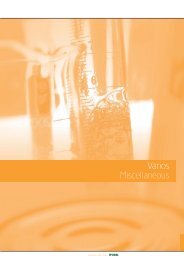Apéndice técnico - Material de laboratorio POBEL
Apéndice técnico - Material de laboratorio POBEL
Apéndice técnico - Material de laboratorio POBEL
You also want an ePaper? Increase the reach of your titles
YUMPU automatically turns print PDFs into web optimized ePapers that Google loves.
<strong>Apéndice</strong> <strong>técnico</strong><br />
Technical Information<br />
Propieda<strong>de</strong>s <strong>de</strong> los fluoropolímeros<br />
Properties of fluoropolymers<br />
El PTFE es el miembro más importante <strong>de</strong> la familia Fluoropolímeros y se caracteriza por sus excepcionales condiciones químico-inertes y por resistir temperaturas<br />
extremas. Otros miembros <strong>de</strong> la familia <strong>de</strong> fluoropolímeros son el PFA y FEP.<br />
El PTFE es procesado utilizando la técnica formación <strong>de</strong> polvo, con sinterización final a 390ºC. Por la formación <strong>de</strong>l PTFE por este método, se pue<strong>de</strong>n encontrar<br />
partículas microscópicas alteradas que en algunas circunstancias pue<strong>de</strong>n ser penetradas por acción química produciéndose una <strong>de</strong>coloración. Asimismo pue<strong>de</strong> haber<br />
un aislamiento <strong>de</strong> las superficies <strong>de</strong> los productos terminados.<br />
El PTFE es uno <strong>de</strong> los mejores materiales antiadherentes que se conocen en la actualidad.<br />
Si un producto en PTFE se sobrecalienta <strong>de</strong> manera inadvertida por encima <strong>de</strong> su temperatura nominal <strong>de</strong> fusión <strong>de</strong> 327ºC, el producto se mantendrá rígido gracias<br />
a su gran viscosidad durante esta fase. Esto quiere <strong>de</strong>cir que los productos en PTFE llevan integrados un factor <strong>de</strong> seguridad. No obstante a 400ºC se podrá observar<br />
algún grado <strong>de</strong> <strong>de</strong>scomposición.<br />
El PFA y el FEP son procesados como termoplásticos convencionales. No tienen partículas alteradas y se presentan como PFA traslúcido y FEP transparente.<br />
Las propieda<strong>de</strong>s químicas y térmicas <strong>de</strong> estos materiales se acercan a las <strong>de</strong>l PTFE pero pue<strong>de</strong>n presentar peligro al alcanzar y rebasar sus temperaturas nominales<br />
<strong>de</strong> fusión y por consiguiente, <strong>de</strong>formarse.<br />
PTFE is the most important member of this family. It has highly stability against most chemicals and it is resistant even over 260 <strong>de</strong>grees Celsius. Another members of<br />
this family are PFA and FEP.<br />
Very high melt viscosity of PTFE prevents the use of usual processing techniques for thermoplastics. Like in pow<strong>de</strong>r metallurgy,PTFE material is first preformed usually<br />
at room temperature, then sintered above the melting point (typically 370ºC), and then cooled. The thermal <strong>de</strong>gradation is negligible in the processing. Additives are<br />
seldom used with PTFE.<br />
The molecular configuration of PTFE brings to its surfaces a high anti-adhesiveness.<br />
PTFE is one of the most thermally stable plastic material. There are no appreciable <strong>de</strong>compositions at 260°C, so that PTFE, at this temperature, still possesses the<br />
greater part of its properties. Appreciable <strong>de</strong>composition begins at over 400°C.<br />
TetraFluorEthylene-Perfluorpropylene(FEP) is produced by copolymerization of tetrafluoroethylene and hexafluoropropylene. It is a relatively soft thermoplastic with<br />
lower tensile strength, wear resistance, and creep resistance than many other engineering plastics. However,it is chemically inert and has a low dielectric constant over<br />
a wi<strong>de</strong> frequency range. FEP possesses a very high <strong>de</strong>gree of stress crack resistance, a low coefficient of friction, exceptional dielectric properties, heat resistance,<br />
retention of properties after service at 204°C with useful properties at -270°C,and meets FDA 21CFR.177.1550.<br />
FEP has high transparency (with good transmittance of UltraViolet and visible wavelengths.) It has long term weatherability and excellent resistance to ozone, sunlight<br />
and weather. FEP offers the lowest refractive in<strong>de</strong>x of all thermoplastics with low light reflection (the same as water).<br />
PerFluoroAlkoxy (PFA) offers similar properties to FEP, but is consi<strong>de</strong>red more of a premium resin. PFA is preferred when exten<strong>de</strong>d service is required in hostile<br />
environments involving chemical, thermal, and mechanical stress. PFA offers high melt strength, stability at high processing temperatures, excellent crack and stress<br />
resistance, a low coefficient of friction, and more than 10 times the Flex life of FEP.<br />
It has high resistance to creep and retention of properties after service at 260°C, with useful properties at 95°C. PFA also meets FDA 21CFR.177.1550.<br />
CARACTERÍSTICAS FEATURES PTFE PFA FEP<br />
Aspecto / Appearance Opaco / Opaque Traslúcido / Translucent Claro / Clear<br />
M.p. ºC 327 305 270<br />
Máx. temp. uso continuo ºC / Max. temp. continuous use ºC 260 - 290 250 205<br />
Máx. temp. uso intermitente ºC / Max. temp. intermittent use ºC 315 280 230<br />
238 CATÁLOGO 2008 / 2009



